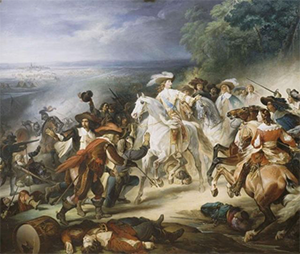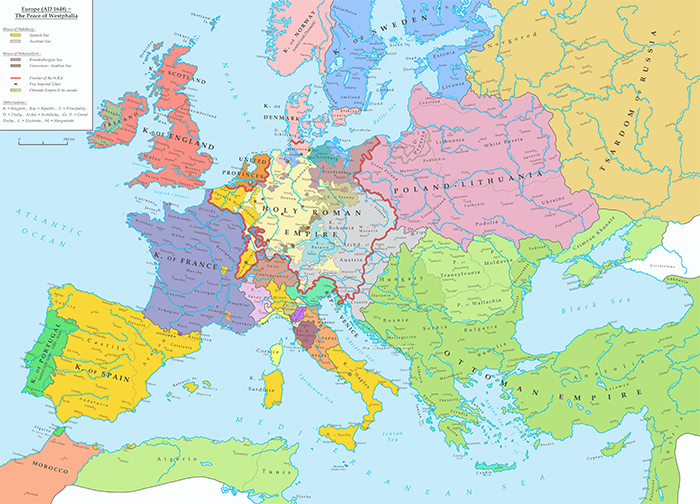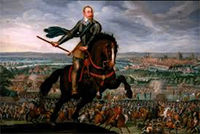The Thirty Years War
Part 3: Peace at Last
The dynamic Gustavus was on the fields of battle for only two years because he died in the Battle of Lutzen in 1632, which was a Swedish victory over the reinstated Wallenstein. Without their dynamic king, the Swedes fought on, but the Catholics again gained the upper hand. The Peace of Prague in 1635 ended the fighting temporarily. Entering the conflict with troops that same year was France. King and Cardinal were Catholic but sided with the Protestants in order to oppose Ferdinand II. Richelieu feared that a Holy Roman Empire victory would leave France encircled by forces loyal to Spain. The French entry into the war tipped the balance in favor of the Protestant forces for a time. Swedish forces, augmented by French men and money, continued to win victories. In 1637, Ferdinand II died. His son, Ferdinand III, kept up the fight. Spanish troops invaded France in 1637 and were eventually turned out. French and Spanish forces fought each other to a standstill after a handful of years. In 1640, Portugal revolted against Spanish rule, forcing Spain to concentrate some of its forces on the home front. In 1642, Sweden re-entered the conflict. Another re-entry came the following year, as Denmark came back into the fray, switching sides to fight with the Holy Roman Empire. The French King Louis XIII died in 1643, and his son, also named Louis, succeeded him. This was the famous Louis XIV, one of the most dynamic figures in European history. At this time, however, he was just 5 years old. 
As had his father before him, this Louis had a powerful Cardinal for a chief minister, the well-known Mazarin. France carried on the war effort, winning a significant victory at Arras and then flooding Flanders with French troops, sending the Spanish reeling. France also scored a decisive victory at Rocroi (right) in 1643 but found a strong setback at the Battle of Herbsthausen in 1645. Things went the Catholic forces' way in Vienna as well, as the defenders there turned back by a furious attack from Swedish forces, which had continued their winning ways, even in the face of the sudden re-entry of Denmark-Norway, on the side of Catholic forces. Another Swedish hero, Marshal Lennart Torstenson, repeated Wallenstein's feat of occupying Jutland and then forced the Danes to sue for peace. Fighting dragged on and on, for a few more years, even as negotiators from all countries met on and off to discuss terms of a truce. Bavaria, Cologne, France, and Sweden signed such an agreement, the Truce of Ulm, in 1647. Spain, despite sending troops home to crush a revolt in Catalan and uprising in Portugal, soldiered on, with Philip IV unwilling to admit defeat until all other options (not to mention his royal forces) were exhausted. The next year brought twin victories for the Protestant side. First, a French force under Louis II de Bourbon, Prince de Condé defeated the Spanish at the Battle of Lens. Then, a Swedish force captured Prague Castle but had insufficient men and weapons to take the entire city; still, the loss of such a landmark and of a number of other Austrian territories accelerated the peace process. Finally, in that same year, representatives from all parties gathered in Germany to hammer out a peace agreement. Representatives signed peace treaties at Münster and Osnabrück on Oct. 24, 1648. These treaties did not cover the war between France and Spain, which continued, albeit at a more relaxed pace for a time.  The number of people who died in the member states during the Thirty Years War is thought to be several million. That includes battlefield deaths and consequent injury-related deaths and deaths from a resulting famine and typhus plague, both of which hit in the wake of the war. The civilian population of a great many cities and towns suffered greatly as a result of this war. Soldiers rampaged through the countryside, taking whatever they could find, leaving some towns with next to nothing left. As well, the governments of the countries and states at war increased what in some cases was already a high rate of taxation in order to pay troops and buy them weapons and other supplies. In political terms, France and Spain remained two of the strongest powers in Europe. The Peace of Westphalia, as the two treaties were known, set the boundaries of many European countries and kingdoms; many of those boundaries remained unchanged for more than a century. First page > Backdrop to a War > Page 1, 2, 3
|
|
Social Studies for Kids
copyright 2002–2025
David White



 The arrival of Sweden, and its famous Gustavus Adolphus (left), in 1630 tipped the scale back the other way, with Protestants regaining much of the territory that they had lost. Sweden's entry into the war coincided with the escalation of French involvement. France, under the well-known
The arrival of Sweden, and its famous Gustavus Adolphus (left), in 1630 tipped the scale back the other way, with Protestants regaining much of the territory that they had lost. Sweden's entry into the war coincided with the escalation of French involvement. France, under the well-known 
